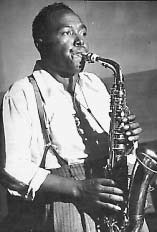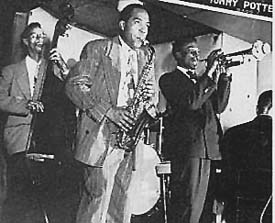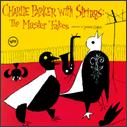

The Birth of a legend | Tough times in California | With Strings |
Charlie Parker...The Bird. So much has already been said. Clint Eastwood even made a movie about him. Like Ellington, Count Basie, and Billie Holliday, Parker's place in the history of jazz is secure despite a relatively short career. Perhaps the main creator of bop (ironically, he found the word "bop" frivolous and degrading to the music) along with cohort Dizzy Gillespie, Parker's blazing lines unfolded a new era in jazz, the lone gun gone wild from the depths of the orchestra, the actor of Greek drama breaking away from the chorus. As if by spontaneous combustion, a number of startling recordings appeared in 1945 and early 1946 on an array of obscure labels. Chief among them were several pieces by Charlie Parker and Dizzy Gillespie that would define a new kind of jazz and serve as a cannon for the modern era--"Groovin' High", "Salt Peanuts", "Hot House", "Anthropology", "Koko", "Ornithology", and the explosive vehicle covered time and time again by so many greats, "A Night in Tunisia". Much of his best work actually was based on show tunes and other popular songs which he modernized, turning it inside out and on it's head, extracting the chord structure and then rendering it unrecognizable.
The Birth of a Legend
Charles Christopher Parker Jr. was born August 29, 1920 in Kansas City, Kansas, but raised in Kansas City, Missouri. Starting on alto at age 11 he would play baritone sax in high school. A highschool drop-out by 15, Parker soon fell into the type of bad company and behavioral patterns that would trouble him for the rest of his life. Early addiction to narcotics was no small part of it. Despite this, his style developed rapidly in the mid-thirties when he left Kansas City to play with George E. Lee's band.
After stints with Jay McShann, Lawrence Keyes and Harlan Leonard (1937-39) Parker spent most of 1939 in New York City playing at Clark Monroe's Uptown House (where he would first meet his future drumming mainstay Max Roach). In April of 1941 on another visit to NYC Parker was recorded for the first time, with Jay McShann on the Decca label. Around this time the young trumpeter making a big sensation in Cab Calloway's band sat in with McShann at the Savoy Ballroom--his name was Dizzy Gillespie.
After leaving McShann, Parker became a regular at Minton's Play House and played clarinet and alto with Noble Sissle for a few months in 1942. Parker and Gillespie finally became bandmates in 1943 in Earl Hines' band where the ever-versatile Parker handled tenor duties for those ten months. Following brief stints with Cootie Williams (where the pianist and arranger was a young Bud Powell) and Andy Kirk, Parker again joined forces with Gillespie in the original Billy Eckstine band in 1944. Parker flourished under the bop-policy of Eckstine.
Recording his first small combo date with Tiny Grimes for the Savoy label in September 1944, it would be the following Spring and in the context of a quintet under Gillespie's leadership that bop jazz first was first committed to record. In May, 1945 seven pieces were recorded, among which were such classics as "Hot House", "Salt Peanuts", "Shaw 'Nuff", "Groovin' High", and "Dizzy Atmosphere". Bop jazz's greatest collaboration of Parker-Gillespie was established. Together and seperately they played regularly on the legendary 52nd Street, earning the respect of fellow musicians and the hostility of cantankerous jazz critics. Between the musicians and the critics lay the public--and they weren't ready to listen yet.
Bottom-out in California
By late 1945 the records had been released and Parker joined Gillespie in California, playing an extended engagement at Billy Berg's. But the natives were restless--if the East Coast wasn't listening to the new sounds of bop the slower West Coast was close to hostile. As a result Parker slipped into heavy use of narcotics to alleviate his dispondency. Nevertheless, when the Berg gig came to an end on January 4, 1946 Parker stayed in California when Gillespie and the rest of the combo went back to New York, a mistake he would pay dearly for.
It was not uncommon for Parker to perform, even record, while high on a combination of narcotics and alcohol. This came to a head when on the night of July 29, 1946, Parker suffered a major nervous breakdown after recording just two pieces at a session for Dial records. He was subsequently arrested and committed to Camarillo State Hospital for six months. However, Parker seems to have recovered as the following two sessions for Dial (one featuring Errol Garner on piano) were strong. And apparently some people were listening--he won the New Star award in the Esquire poll of 1946.
Charlie Parker Quintet
 Returning to New York on April 4, 1947, Parker appeared to be recovered and in fine spirits, even sitting in with Gillespie's big band the next evening at the Savoy Ballroom, the same venue where they had met for the first time five years previous. He soon got down to business and formed his own "classic" quintet with a young Miles Davis, Duke Jordan (p), Tommy Potter (b), and Max Roach on drums. Recording simultaneously for the Dial and Savoy labels, they would record and rerecord Parker's growing archive of jazz classics, most of them developed from popular tunes "bopized" beyond recognition, and renamed (to the relief of the recording labels who could then avoid the matter of paying royalties).
Returning to New York on April 4, 1947, Parker appeared to be recovered and in fine spirits, even sitting in with Gillespie's big band the next evening at the Savoy Ballroom, the same venue where they had met for the first time five years previous. He soon got down to business and formed his own "classic" quintet with a young Miles Davis, Duke Jordan (p), Tommy Potter (b), and Max Roach on drums. Recording simultaneously for the Dial and Savoy labels, they would record and rerecord Parker's growing archive of jazz classics, most of them developed from popular tunes "bopized" beyond recognition, and renamed (to the relief of the recording labels who could then avoid the matter of paying royalties).
More to come on this fantastic quintet in the months ahead
Charlie Parker "With Strings"
However, it was immediately following his release from the hospital in California that Parker began an association that would first break him into the public spotlight. For it was at this time that he joined up with the massive Jazz at the Philharmonic (JATP) series of concerts and recordings and came under the supervision of it's organizer, Norman Granz, the chief producer of the record labels that would later come under the family name of Verve (Clef, Mercury, Nogran).
At the close of 1947, under the auspices of Clef and JATP, Parker performed at Carnegie Hall with his quartet while Neal Hefti performed at a different part of the Hall. After Parker paid a visit to Hefti's session it was decided that Parker would improvise over Hefti's arrangement and orchestra. That single track, "Repitition", heralded the start, for better or worse, the "with String" craze that followed the names of many recording stars: Stan Getz, Chet Baker, even Clifford Brown.
There has been a fair amount of flack leveled against these perpetrators of "string" accompaniment, and no small amount directed at Norman Granz. The accusations usually fall along the lines of "gross commercialization" and as such may be justified. It certainly did sugar-coat what was otherwise bop's bitter pill to the ears of the general public. Interestingly, Parker took particular pride in the Parker with Strings recordings that would follow. He had attempted to study with such avant-garde composers as Edgard Varèse and Stefan Wolpe, and perhaps was hoping to succour Granz in that direction for future projects.

(left to right) Buddy Rich, Ray Brown, Charlie Parker,
Max Hollander, Mitch Miller(!), Milt Lomask.

 There were a number of sessions of Charlie Parker with Strings over a three year period beginning late 1949. These sessions included at various times Buddy Rich or Roy Haynes on drums, Tommy Potter or Ray Brown on bass, and on the initial studio session (Nov. 30, 1949), the great mad-man of sing-along, Mitch Miller, holding down some hefty oboe riffs. But the standout session is the live performance captured at Carnegie Hall Sept. 17, 1950, which included a sweetly small string section and a prominent rhythm section of Al Haig (p), Potter and Haynes. Parker's "with Strings" live performances along with the studio master takes have been collected in Verve's Charlie Parker with Strings: The Master Takes. This album, clocking in at a hefty 76 minutes, is lightly recommended by the Jazznote--of particular interest mostly to Parker die-hards.
There were a number of sessions of Charlie Parker with Strings over a three year period beginning late 1949. These sessions included at various times Buddy Rich or Roy Haynes on drums, Tommy Potter or Ray Brown on bass, and on the initial studio session (Nov. 30, 1949), the great mad-man of sing-along, Mitch Miller, holding down some hefty oboe riffs. But the standout session is the live performance captured at Carnegie Hall Sept. 17, 1950, which included a sweetly small string section and a prominent rhythm section of Al Haig (p), Potter and Haynes. Parker's "with Strings" live performances along with the studio master takes have been collected in Verve's Charlie Parker with Strings: The Master Takes. This album, clocking in at a hefty 76 minutes, is lightly recommended by the Jazznote--of particular interest mostly to Parker die-hards.
The Final Stretch
However, with the onset of the fifties, the years that would bring the kind of jazz Parker had worked so hard to establish, Parker began his final downward spiral. In 1951 his New York cabaret license was revoked making it difficult to play in the very clubs he made a name for himself. And although his playing was still capable of fantastic heights of execution he more and more often stumbled--and he was aware of it. In 1954 he twice attempted suicide before spending time in Bellevue. Parker passed away March 12, 1955.
So concludes Part 1 of Charlie Parker at the Jazznote--Part 2, the Final Years, will be here soon!

HOME | TOP | ARTISTS
 Returning to New York on April 4, 1947, Parker appeared to be recovered and in fine spirits, even sitting in with Gillespie's big band the next evening at the Savoy Ballroom, the same venue where they had met for the first time five years previous. He soon got down to business and formed his own "classic" quintet with a young Miles Davis, Duke Jordan (p), Tommy Potter (b), and Max Roach on drums. Recording simultaneously for the Dial and Savoy labels, they would record and rerecord Parker's growing archive of jazz classics, most of them developed from popular tunes "bopized" beyond recognition, and renamed (to the relief of the recording labels who could then avoid the matter of paying royalties).
Returning to New York on April 4, 1947, Parker appeared to be recovered and in fine spirits, even sitting in with Gillespie's big band the next evening at the Savoy Ballroom, the same venue where they had met for the first time five years previous. He soon got down to business and formed his own "classic" quintet with a young Miles Davis, Duke Jordan (p), Tommy Potter (b), and Max Roach on drums. Recording simultaneously for the Dial and Savoy labels, they would record and rerecord Parker's growing archive of jazz classics, most of them developed from popular tunes "bopized" beyond recognition, and renamed (to the relief of the recording labels who could then avoid the matter of paying royalties).




 There were a number of sessions of Charlie Parker with Strings over a three year period beginning late 1949. These sessions included at various times Buddy Rich or Roy Haynes on drums, Tommy Potter or Ray Brown on bass, and on the initial studio session (Nov. 30, 1949), the great mad-man of sing-along, Mitch Miller, holding down some hefty oboe riffs. But the standout session is the live performance captured at Carnegie Hall Sept. 17, 1950, which included a sweetly small string section and a prominent rhythm section of Al Haig (p), Potter and Haynes. Parker's "with Strings" live performances along with the studio master takes have been collected in Verve's Charlie Parker with Strings: The Master Takes. This album, clocking in at a hefty 76 minutes, is lightly recommended by the Jazznote--of particular interest mostly to Parker die-hards.
There were a number of sessions of Charlie Parker with Strings over a three year period beginning late 1949. These sessions included at various times Buddy Rich or Roy Haynes on drums, Tommy Potter or Ray Brown on bass, and on the initial studio session (Nov. 30, 1949), the great mad-man of sing-along, Mitch Miller, holding down some hefty oboe riffs. But the standout session is the live performance captured at Carnegie Hall Sept. 17, 1950, which included a sweetly small string section and a prominent rhythm section of Al Haig (p), Potter and Haynes. Parker's "with Strings" live performances along with the studio master takes have been collected in Verve's Charlie Parker with Strings: The Master Takes. This album, clocking in at a hefty 76 minutes, is lightly recommended by the Jazznote--of particular interest mostly to Parker die-hards.